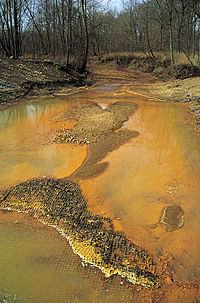Mining
From Wikipedia, the free encyclopedia.

Mining is the extraction of valuable minerals or other geological materials from the earth, usually (but not always) from an ore body, vein, or (coal) seam. Materials commonly recovered by mining include bauxite, coal, copper, diamonds, iron, gold, lead, manganese, magnesium, nickel, phosphate, platinum, rock salt, silver, tin, titanium, uranium, and zinc. Other highly useful materials that are mined include clay, sand, cinder, gravel, granite, and limestone. Any material that cannot be grown from agricultural processes must be mined. Mining in a wider sense can also include extraction of petroleum and natural gas.
Contents |
History
The oldest known mine in the archaeological record is the "Lion Cave" in Swaziland. At this site, which has a radiocarbon age of 43,000 years, paleolithic humans mined for the iron-containing mineral hematite, which they presumably ground to produce the red pigment ochre.
Sites of a similar age where Neanderthals may have mined flint for weapons and tools have been found in Hungary.
Another early mining operation was the turquoise mine operated by the ancient Egyptians at Wady Maghareh on the Sinai Peninsula. Turquoise was also mined in pre-Columbian America in the Cerillos Mining District in New Mexico, where a mass of rock 200 feet (60 m) in depth and 300 feet (90 m) in width was removed with stone tools; the mine dump covers 20 acres (81,000 m²).
Black gun powder in mining was first time used in a shift Bartolomej in mines under the town Banská Štiavnica, Slovakia in 1627. There is 12000 kilometers of tunnels under this small town drived for a 1000 years.
Mining techniques
Mining techniques can be divided into two basic excavation types:
1. Surface mining
Extractive metallurgy
The science of extractive metallurgy is the study of beneficiation and extraction of valuable metals and minerals from their ores. Although extractive metallurgy is all encompassing, mineral processing or mineral dressing is often the term used for the study of processing coal, industrial minerals and precious stones, as these are not metals.
Environmental effects

Modern mining companies in many countries are required to follow strict environmental and reclamation codes, ensuring the area mined is returned to its original state, or an even better environmental state than before mining took place. Past mining methods have had, and methods used in countries with lax environmental regulations continue to have, devastating environmental and public health effects. The result can be unnaturally high concentrations of some chemical elements over a significantly wider area of surface. Combined with the effects of water and the new 'channels' created for water to travel through, collect in, and contact with these chemicals, a situation is created where mass-scale contamination can occur.
Some examples of environmental problems associated with mining operations are:
- Tar Creek, an abandoned mining area in Picher, Oklahoma that is now an Environmental Protection Agency superfund site. Water in the mine has leaked through into local groundwater, contaminating it with metals such as lead and cadmium. [1]
- Scouriotissa, a copper mine in Cyprus that has been abandoned. Contaminated dust blows off this site.
- Berkeley Lake, an abandoned pit mine in Butte, Montana that has filled with water which is now acidic and poisonous.
- Britannia Mines, a copper mine in near Vancouver, BC. Copper from the abandoned mine is washed into Howe Sound, polluting the water there. No animal life is there now.
Although such issues have been associated with some mining operations in the past, modern mining practices have improved significantly and are subject to close environmental scrutiny. Problems remain especially in countries with lax environmental regulations or enforcement.
Mining industry
While exploration and mining can sometimes be conducted by individual entrepreneurs or small business, most modern-day mines are large enterprises requiring large amounts of capital to establish. Consequently, the industry is dominated by large, often multinational, mostly publicly-listed companies. See Category:Mining companies for a list.
Mine Planning Software
One of the most dramatic changes in the mining industry has been the role that sophisticated three dimensional 3-D mine planning software packages have had. Initially relatively simple tasks - like rendering graphic images of drill holes - meant that it became easier for surveyors, geologists, mine planners, mining engineers and other technical staff to manipulate and visualize data. However, in recent years the range of integrated mine planning tools have meant that massively complex models can be built to optimize the extraction and processing of mineral resources.
See also
References
- Tom Morrison. 1992. Hardrock Gold: A Miner's Tale (ISBN 0806124423)
- Geobacter Project: Gold mines may owe their origins to bacteria (in PDF format)




